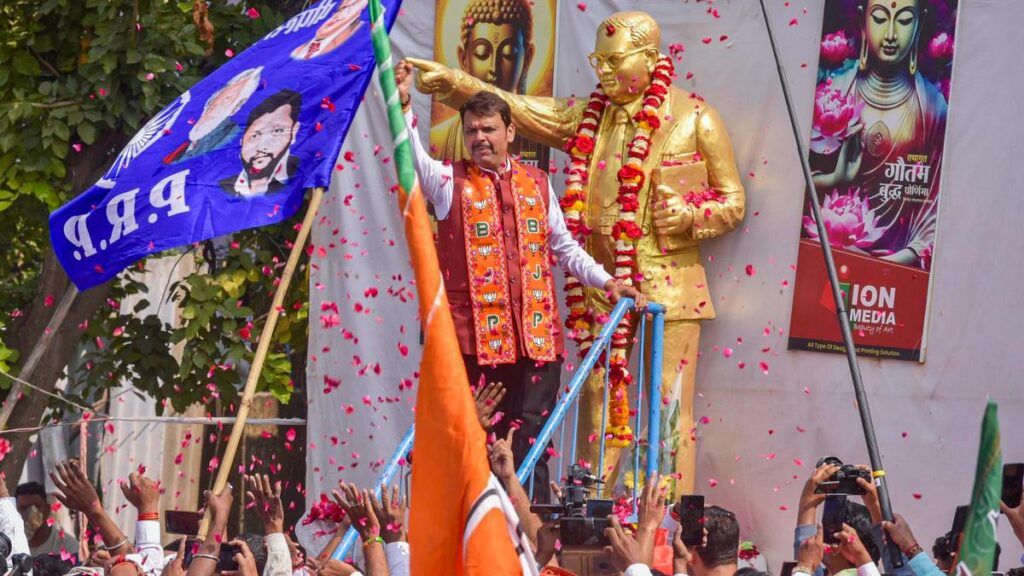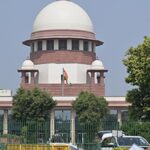
Since the formation of the State in 1960, Maharashtra has been dominated for a long period by the Congress System, stitching a cross-sectional alliance between the dominant agrarian caste of the Maratha-Kunbi group and effective support from Dalits and Muslims. Scholars have also used the term “bahujan politics” to describe this kind of cross-sectional alliance first orchestrated by veteran Congress leader Y.B. Chavan. The electoral success of this political mobilisation meant that successive Congress Chief Ministers also tried to replicate their own versions of this model to ensure the continuance of Congress rule in the State. However, the emergence of the Bharatiya Janata Party (BJP) and Shiv Sena, in alliance with each other, introduced new dimensions to the political arena in the 1990s, emphasising Hindutva and regional pride. This altered the electoral dynamics and political discourse of the State, especially at a time when agricultural growth had stagnated and the economy was adapting to a transition to rapid industrial growth amidst privatisation.
Caste plays a pivotal role in Maharashtra politics despite claims of progressive social movements and rapid economic growth, both of which were expected to make caste obsolete in the social milieu. The dominant caste position is enjoyed by Marathas, who not only have a high numerical presence but, when disaggregated into Maratha-Kunbis, are also geographically spread and control levers of economic power by owning land and extensive networks of sugar cooperatives and control over local governance structures. The Marathas have also legitimised their position as the dominant caste through their historical association and lineage from Chhatrapati Shivaji Maharaj, who is one of the most influential historical personalities to have impacted the thought behind a Maharashtrian identity, more so than Ambedkar or Jyotiba Phule to some extent.
Historically speaking, Brahmins of the State have also exerted disproportionate influence over political power; however, the politics of modern Maharashtra have largely been organised around the idea of non-Brahmin mobilisations, which is even visible in the discomfort among certain political classes to accept the leadership of Brahmin politicians like Manohar Joshi in the past or Devendra Fadnavis in the more contemporary scenario. The Other Backward Classes (OBCs), including communities like the Malis, Dhangars, and Vanjaris, have been mobilised by parties like the BJP to counterbalance Maratha hegemony. Leaders like Gopinath Munde have been instrumental in consolidating OBC support for the BJP, reshaping electoral dynamics by successfully replicating some of the tested models of local patronage networks of cooperatives used by the Maratha leadership to develop his own political constituency in Beed and adjoining districts.
Dalit politics is also significant, with communities like the Mahars (Navayana Buddhists, also called Nav Baudh) asserting their influence, particularly in regions like Vidarbha. Parties like the Republican Party of India (Athawale) and the Vanchit Bahujan Aghadi (VBA) seek to represent Dalit interests, often impacting electoral outcomes in key constituencies, as their electoral impact is largely localised to a few pockets in suburban Mumbai-Thane and Akola, although their political impact ensures that issues of Dalit interest are not completely sidelined by other political parties.
Regional disparities further complicate the political landscape. For instance, Vidarbha’s agrarian distress and demand for separate statehood influence its political leanings, while Mumbai-Thane’s urban issues and cosmopolitan demographics create different priorities. The Konkan region’s unique socio-cultural fabric adds another layer of complexity.
Shifting dynamics of State politics are easy to identify by looking at the changing dynamics of party competition within these different sub-regions, where each region sees the dominance of different parties at different points in time. For example, Vidarbha, which sends 62 MLAs to the assembly, sees a close contest between the BJP and Congress. Traditionally seen as a Congress bastion, it was also the region where the BJP started its expansion in the State, and much of the BJP’s state-level leadership comes from this region — a testimony to the importance of Vidarbha in the BJP’s expansion in Maharashtra. Western Maharashtra is usually dominated by cooperative society barons who have comfortably switched between Congress and NCP to continue their hold over these rural networks of power. The BJP’s emergence as a key stakeholder in the politics of the region has depended on the party’s ability to co-opt many of these sugar and education barons into their own party fold. The Konkan and Mumbai region have seen the Shiv Sena as a dominant political force for a long time with steady expansion in the Marathwada region, especially in the wake of the Namantar movement. However, BJP, Congress, and NCP have also created pockets of influence in different parts of Marathwada, mostly by co-opting the local dominant political elites rather than building their own cadre base in new areas of expansion.
It is the supremacy of these local political elites in different parts of the State, substituting grassroots party organisation with their own networks of faction supporters, that makes politics in Maharashtra so hyper-localised, even if the discourse is largely centred around state-wide issues.
Put otherwise, Maharashtra’s politics cannot be viewed through a singular lens. It is a confluence of caste equations, regional aspirations, economic interests, dominance of local political elites, and the strategic manoeuvers of political parties aiming to capitalise on these factors.
On party splits
Maharashtra has largely followed a bipolar party system where Congress and the opposition to Congress, either from within or outside, were the two poles of party competition. This trend continued uninterrupted till the 2014 Assembly elections when all the four major political parties contested the elections independently without entering into any pre-poll alliance for the first time, leading to party-system fragmentation. Although there was a post-poll alliance after the results, which led to political realignment among the parties, the cleavages emerging from this fragmentation paved the way for further party fragmentation in Maharashtra in the post-2019 elections. The splintering of major parties, such as the Shiv Sena into factions led by Eknath Shinde and Uddhav Thackeray, and the split within the Nationalist Congress Party (NCP), has reshaped the political landscape so much that one of the key electoral discourses is to take the 2024 Assembly elections as a test for the credibility of respective party factions as the “original” party — for both Shiv Senas and the NCPs. While the legal challenges have partially ended in favor of Eknath Shinde, as the Shiv Sena led by him retains the bow and arrow symbol, and the Ajit Pawar faction of NCP retaining the clock symbol, the challenge in the people’s court is keenly awaited as the Maharashtra voter goes to the polling station on November 20.
In the past decade, the BJP has become a formidable force in Maharashtra, the most powerful it has ever been. Yet, it has faced challenges in countering Shiv Sena’s brand of Hindutva in the state. Shiv Sena, being a regional party, has an additional arsenal that the BJP does not — Maharashtra dharma, or regional pride.
After first breaking up their long-term alliance with the BJP before the 2014 assembly elections, Shiv Sena reconciled with their estranged partner in the State to take up a junior role in the post-poll alliance in the BJP-led NDA Government, which could be best described as an unhappy alliance, and Shiv Sena made no efforts to hide this discomfort by constantly playing the role of opposition within the government. After the Assembly elections in 2019, following a period of intense political drama, the Shiv Sena, in a drastic attempt to keep their brand of politics intact while striving to be in the power center, departed from the BJP’s alliance and joined the unlikely Maha Vikas Aghadi (MVA) alliance with secular parties like the NCP and Congress. In 2022, a faction within the Shiv Sena led by Eknath Shinde rebelled against their party’s dynast Uddhav Thackeray, who was the sitting Chief Minister, and joined hands with the BJP. This forced the MVA government to lose their majority in the assembly, and the BJP, in turn, offered Eknath Shinde the Chief Minister’s seat. By 2022, there were two Shiv Senas, one NCP, one BJP, and one Congress. A year later, following a familiar script, Ajit Pawar led a faction that broke out of Sharad Pawar’s NCP. Ajit Pawar also joined the NDA and became a Deputy Chief Minister of the State along with Devendra Fadnavis of the BJP.
Thus, there came to be two alliances, each consisting of three parties — MVA: Shiv Sena (Uddhav Balasaheb Thackeray), NCP (Sharad Pawar), and Congress; and NDA: Shiv Sena (Eknath Shinde), NCP (Ajit Pawar), and BJP.
This fragmentation has resulted in a degree of cynicism among the electorate, stemming from perceived opportunism and the erosion of ideological commitments. Voters witness erstwhile rivals forming alliances or party leaders switching affiliations, which can undermine trust in political institutions and leaders. The entry of new parties and the realignment of existing ones often lead to confusion and disillusionment among constituents who feel their mandates are being subverted by political expediency.
Because of the present coalition politics of the big three on each side, the candidature in each constituency has often gone to just one party within an alliance. This has led to an increase in the number of rebel candidates in every other constituency from each alliance. Due to the seat-sharing dilemmas, both alliances have suffered heavily. Until the very last minute of filing nominations, probable candidates and parties ran from pillar to post. Many times, multiple candidates from the same party and alliance filed their nominations, often twice — once on the party’s ticket and another as an independent. The political fragmentation has further resulted in cynicism.
Though it has been more than a year since the political upheavals in the State, people on the ground are still in a confused state. The split of parties across two ideological fronts has stirred a unique level of confusion. The people are not very aware or conscious of the changed waves. For instance, a street vendor might express his intent to vote for the BJP, not realizing that there is no BJP candidate in his constituency and that the BJP’s alliance partner NCP is contesting from the seat. Upon being told, he might still insist on voting for a BJP person who is contesting as an independent. He is not an exception but rather represents the norm for most people who are still very unaware or confused. Plus, there is an added burden of vote transfer between alliance parties.
Conversely, fragmentation has also heightened political awareness and engagement. The emergence of new parties and factions provides voters with alternative platforms that may align more closely with their specific regional, caste-based, or economic interests. It encourages political discourse and compels parties to be more responsive to the needs of their constituents to secure electoral support.
Moreover, fragmentation has intensified competition, prompting parties to address localised issues more earnestly. It has led to increased representation of marginalized groups, as new political entities seek to mobilise support by advocating for the rights and concerns of these communities.
In essence, while party fragmentation has introduced elements of cynicism due to perceived instability and opportunism, it has simultaneously fostered greater political engagement and provided opportunities for more nuanced representation within Maharashtra’s diverse society.
Diminishing role of ideology
The formation and crystallisation of political alliances in Maharashtra are driven by a complex interplay of leadership personalities, patronage networks, caste groups, and broad ideological framing of secular vs. non-secular politics, although the ideological positions are increasingly fading away.
Leadership personalities wield significant influence in alliance formations. Charismatic leaders with strong regional or community support bases often become pivotal in negotiations. For instance, leaders like Sharad Pawar of the NCP, with his deep-rooted influence among the Marathas, play a crucial role in crafting alliances.
Patronage networks are perhaps the most significant drivers. The extensive cooperative networks in banking, finance, sugar, and dairy, predominantly controlled by Maratha elites, facilitate the distribution of resources and favors, binding communities to specific parties. These networks enable parties to mobilise support effectively, making them central to alliance considerations. Control over local institutions and economic resources often dictates alliance preferences, as parties seek to consolidate or expand their patronage reach.
Ideology, while present, often takes a backseat to pragmatic considerations in Maharashtra’s alliances. Although parties like the BJP and Shiv Sena share a Hindutva ideology, their alliances are also influenced by strategic needs to counter other dominant groups. The Maha Vikas Aghadi (MVA) alliance between the Shiv Sena (Uddhav faction), NCP, and Congress is a case where ideological differences were set aside to form a government, primarily to prevent the BJP from gaining power.
The recent political fragmentation has further influenced alliance formations. For example, in the current scenario, there are two alliances, each consisting of three parties: the MVA and the NDA, each with factions of Shiv Sena and NCP, along with either the Congress or BJP. This fragmentation and the unholy alliances have put voters in a state of dilemma. For a party known as the fountainhead of Hindutva in the state, Shiv Sena (UBT) now sits with a secular alliance in the MVA, while the other Shiv Sena continues in the Hindutva alliance of the NDA. Whereas the Ajit Pawar faction of the NCP, otherwise a secular party, shares power with the NDA. In the midst of all this, the voter feels confused, unaccounted for, and unheard.
In the present coalition politics of the big three on each side, the candidature in each constituency often goes to one party, leading to an increase in rebel candidates. Due to seat-sharing dilemmas, both alliances have suffered heavily. Many candidates have filed nominations both on party tickets and as independents, further complicating the political landscape.
In other words, while ideology provides a broad framework, it is the leadership personalities and patronage networks that are the primary drivers in the crystallisation of political alliances in Maharashtra. Alliances are often formed based on strategic calculations to maximise electoral success and consolidate power rather than purely on shared ideological grounds.
Significance of AIMIM
Muslims consist of 11% of Maharashtra’s total population and yet have always been underrepresented in electoral politics in proportion to their numerical strength. Although the population is dispersed across different geographical subregions of the state, there are about 30–40 constituencies in which the Muslim voters play a decisive role in deciding the electoral outcome. The All India Majlis-e-Ittehadul Muslimeen (AIMIM), led by Asaduddin Owaisi, has emerged as a significant player in shaping Muslim politics in Maharashtra. The party has sought to represent the interests of the Muslim community by addressing issues such as discrimination, socio-economic development, and political representation.
AIMIM’s entry into Maharashtra politics has been marked by contesting elections in Muslim-majority constituencies, gradually starting from Marathwada and then extending up to the Mumbai-Thane region. The party has had some electoral success, winning seats in the state assembly and local bodies and even one odd parliamentary seat in Aurangabad in 2019, thereby establishing a foothold in the state’s political arena.
Owaisi’s strategy includes attempting to forge a Muslim-Dalit coalition to consolidate marginalised communities under a common platform. This strategy is also being used by a new party like Azad Samaj Party, which is putting up Muslim candidates in some constituencies across Maharashtra. By emphasizing the shared experiences of discrimination and socio-economic challenges, AIMIM aims to unite these groups to enhance their political influence. However, the success of this coalition has been limited, as the MIM and Bheem alliance has not percolated well at the grassroots level.
In Maharashtra, Muslim politics continues to be in a dismal socio-political state. In this election, Muslims have become mere vote banks for parties. In the Lok Sabha, Muslims overwhelmingly supported the INDIA bloc. The MVA alliance has only offered 13 tickets to Muslims out of 288 assembly seats. Muslims on the ground lie in an extremely polarised situation; they cannot vote for Hindutva parties in the NDA, and there is a general discontent of being taken for granted by the MVA bloc without appropriate representation.
In a turn of political weather, Shiv Sena (UBT) has emerged as a party Muslims could rally behind. Uddhav Thackeray, who would otherwise open his rallies and speeches with “Ithe jamlelya mazya tamam Hindu bandhav, bhagini, ani matanno” (all those of my Hindu brothers, sisters, and mothers gathered here), has changed his tone to “Tamam Maharashtra premi” (all Maharashtra lovers) to accommodate his changed voter constituency. He further goes on to add, “Mumbra is as much ours” — Mumbra being the biggest Muslim ghetto in the outskirts of Mumbai. The wheel of history rotates; Mumbra was a small area prior to 1993, when the riots hit Bombay and Muslims were forced to relocate to the outer periphery of Mumbai —curiously, it is the same Shiv Sena which had a major role in propagating Hindu-Muslim riots. Certainly, UBT-led Shiv Sena has come a long way around the wheel.
Meanwhile, the BJP and alliance partners, to polarise further, have resorted to calling it “Vote Jihad” and “Batenge toh Katenge” narratives so that Hindu votes stay rallied behind the NDA.
The rise of AIMIM has prompted other political parties to reassess their strategies for mobilizing Muslim support. The Congress and the Nationalist Congress Party (NCP) have traditionally relied on secular and inclusive narratives to attract Muslim voters. They emphasise policies aimed at minority welfare, protection of rights, and opposition to communal politics. In 2014, just before the announcement of the Assembly elections, the then Congress-NCP government led by Chief Minister Prithviraj Chavan announced 16% reservation for the Marathas and 9% reservation in higher education and government jobs for the Muslims. The BJP, upon coming to power with the undivided Shiv Sena in 2014, canceled the reservation allocated for the Muslims, citing it as discrimination on the basis of religion, while continuing with the 16% reservations for the Maratha community, which was ultimately canceled by the Bombay High Court.
AIMIM was most successful in 2019 when, in alliance with VBA, they could elect one MP and two MLAs, though they have been unable to build over their voter base. The Dalit-Muslim consolidation that aided both VBA and AIMIM has now spilled over to the MVA bloc. There is a general consensus on “not letting a vote go to waste” among Muslims—”why vote for AIMIM when they are not going to win and cause a further split in MVA who would otherwise win.” In fact, even in 2024, the MVA is putting in a lot of effort to drive home the narrative that “a vote for the ghadi (clock—symbol of NCP Ajit Pawar) is a vote for the BJP,” as among the Mahayuti allies, NCP Ajit Pawar is proactively projecting itself as a secular party, giving party tickets to most of the Muslim candidates who will be contesting the Assembly elections in 2024.
The AIMIM has become a noteworthy influence in Muslim politics in Maharashtra by directly addressing community-specific concerns and seeking to build alliances with other marginalized groups. While Owaisi’s efforts to create a Muslim-Dalit coalition face challenges, he has been successful in establishing a new educated class of politicians who are challenging the dominance of entrenched political elites. The party’s presence has compelled mainstream parties to actively engage with the Muslim electorate and address their issues more substantively.
Sarthak Bagchi teaches at Ahmedabad University; Vignesh Karthik KR is a postdoctoral research fellow at KITLV-Leiden; Susmit Panzade, Pradip Kapse, and Sumeet Gurli are researchers based in Maharashtra. This is the first article in a two-part series on Maharashtra politics.
Published – November 13, 2024 08:30 am IST
इसे शेयर करें:



